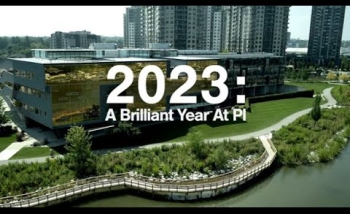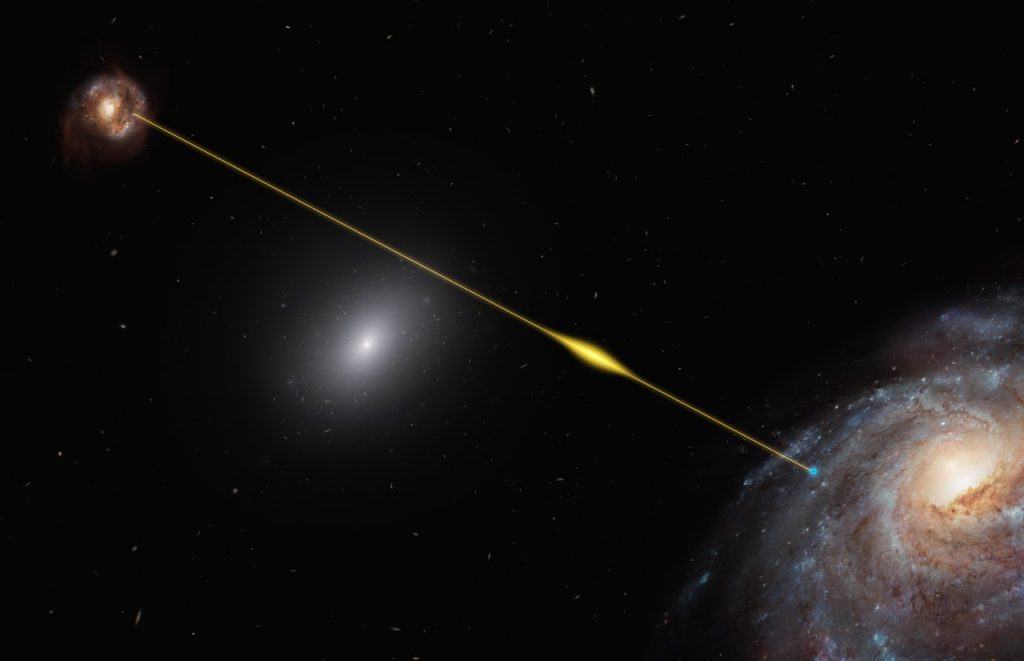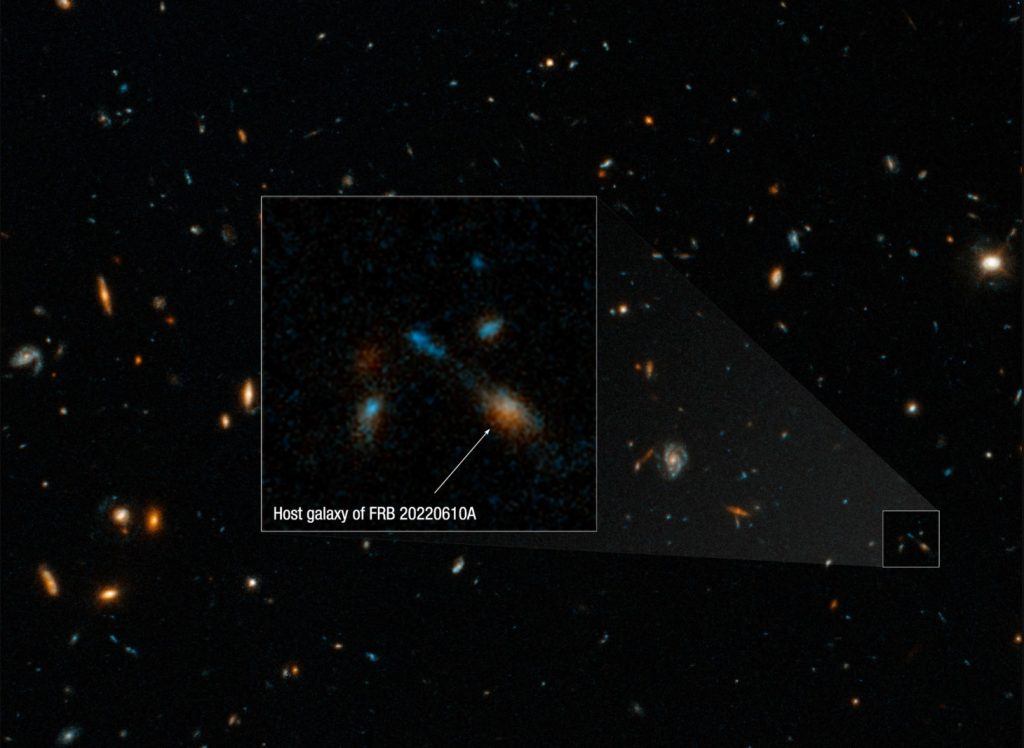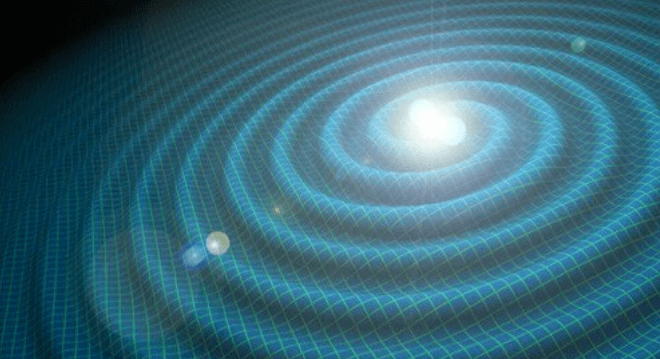Our night sky is not serene. It’s bursting with activity – and we didn’t know it until recently.
That’s because this activity comes in the form of radio wave bursts, invisible to our eyes, and lasting only moments. The first one was discovered in 2007, when astronomers digging through old data caught sight of a lighting-quick blast of energy coming from the direction of the Small Magellanic Cloud, a nearby dwarf galaxy. The burst hit the dish of the Parkes Radio Telescope in Australia, and it got scientists wondering whether there might be more events like it.
When they went looking for more, they found them.
Astronomers have now recorded hundreds of fast radio bursts (FRBs), as they’ve since been called, using powerful instruments like the Canadian Hydrogen Intensity Mapping Experiment (CHIME). Each FRB lasts between a few milliseconds and a few seconds. They occur all over the sky, and they are violent events. Each one, on average, releases energy equivalent to three days of output from the Sun, though the signal strength is diluted and weak by the time it reaches Earth.
With new FRBs being discovered regularly, there are bound to be surprises. So, let’s dig into five of the most wild and wonderful of these bursts that go bump in the night:
FRB 20200428A – Hitting close to home
Until April 2020, every theory about what causes FRBs was just that – a theory. There wasn’t enough observational evidence to properly corroborate scientists’ best guesses. Every FRB ever found had come from too far away to pinpoint their place of origin.
That all changed with FRB 20200428A. At the same time that radio observatories like CHIME caught its signal, X-ray observatories in space and on Earth simultaneously captured X-ray bursts from the same location, enabling astronomers to hone in on the FRB’s source. And it was coming from nearby.
FRB 20200428A was the first FRB found within our own galaxy, spawning from a star just 30,000 light-years away – practically in our own galactic backyard. And it was no ordinary star. It was a magnetar.
Magnetars are a type of neutron star with extremely energetic magnetic fields. They form in the death throes of supergiant stars gone supernova. In the aftermath of a supernova explosion, some of the remaining stellar material collapses into a hot core denser than anything in the universe, besides a black hole.
Though tiny, magnetars are unruly objects, and launching FRBs from their magnetospheres is well within their capability.
Because of this discovery, we can now be sure that at least some FRBs are caused by magnetars – some, but probably not all, because there are FRBs out there whose profiles just don’t match the magnetar hypothesis. For example…
FRB 20121102A – A Frankenstein monster
This one is weird. FRB 20121102A isn’t a one-time burst. It repeats. When it was discovered in 2012, it was the only known repeating FRB, though now there are dozens of others (in fact, there is a hypothesis gaining steam among some corners of the astronomical community that all FRBs repeat, eventually – but take that theory with a grain of salt for now).
Repeating isn’t what makes FRB 20121102A weird, however. What makes it weird is that ‘repeating’ is an understatement: it practically bursts continuously, with a level of activity well beyond anything that could be produced by a magnetar – at least, any magnetar we’ve ever seen.
And sometimes, it just shuts off. FRB 20121102A occasionally goes dark for a while, before coming back to life as strong as ever. If it is caused by a magnetar, it’s something unique – perhaps a very young one, one that formed in unusual circumstances, or one that has a long rotation period unlike anything we’ve ever observed.
This FRB still has astronomers scratching their heads, but it isn’t the most powerful FRB ever found. That title goes to…
FRB 20220610A – The Big One
This is the most distant – and most ancient – FRB yet discovered. It is more than eight billion years old and travelled halfway across the observable universe to reach us. It’s four times as energetic as any FRBs closer to home, making it – by a long shot – the most powerful FRB seen to date.
In 2024, astronomers announced that they had aimed Hubble at the area of the sky where this FRB originated, and found a swirling vortex of seven tiny dwarf galaxies all caught in each other’s webs, interacting and diving towards an impending merger.
Astronomers think these galactic interactions could be triggering new star formation. A common theme among most FRBs is that they tend to occur in regions with lots of new, young stars, and this observation lends credence to that theory.
Besides being the biggest, FRB 20220610A is breaking expectations in other ways too. As an FRB travels through the universe toward Earth, it occasionally bumps into free-floating particles along the way. These collisions cause some wavelengths of the FRB to arrive later than others, an effect called dispersion. By measuring the dispersion pattern, astronomers can estimate how much interstellar material is floating in space between us and the FRB’s source.
Almost every FRB’s dispersion pattern looks similar, growing larger with distance, at a known rate. But there are two startling exceptions, and FRB 20220610A is one of them.
Astronomers theorize that some kind of magnetized plasma storm must have interfered with the FRB early in its travels, throwing its dispersion measurement off. Perhaps the tangled environment where it was born, amidst seven colliding galaxies, is an exceptionally chaotic place. But it also means astronomers need to be cautious about using dispersion measurements lightly – FRB 20220610A has made it clear that, sometimes, the numbers can be thrown out of whack.
FRB 20191221A – Tick tock, it’s a clock!
This FRB isn’t a repeating signal; it’s a one-off. But it lasted three seconds – that’s very long for an FRB. And within those three seconds, there was a very distinct, repetitive ticking pattern that occurred every 0.2 seconds.
The ticking phenomenon was unusual, and had researchers like Perimeter’s Kendrick Smith eager to investigate.
As it turns out, that ticking was an incredibly useful clue to the FRB’s origin. By measuring the periodicity (the intervals between the ticks), scientists were able to determine that the signal matched what you would see if it came from a neutron star spinning around its axis every 217 milliseconds (0.2 seconds).
Astronomers had never before been able to tie a non-repeating FRB to a neutron star, so this was an exciting discovery. It even helped narrow down the mechanism behind the FRB explosion, tying the effect to the star’s magnetosphere rather than to something further away from the star’s surface, like ejected particles interacting with interstellar material or nebulae.
Unravelling the mystery of FRB 20191221A’s ticking was a breakthrough, and it has shaped how astronomers think about FRBs. But the final FRB on this list might surpass it, because it may help us understand the ‘gravity’ of the situation…
FRB 20190425A – Making waves
We’ve already discussed an FRB that was seen by both radio and X-ray telescopes. But FRB 20190425A has the unique distinction of being seen by both radio telescopes and a gravitational wave detector.
Probably.
On April 25, 2019, CHIME recorded an energetic FRB. The same day, the Laser Interferometer Gravitational-Wave Observatory (LIGO) detected gravitational waves from the collision of two neutron stars. Both events occurred within the same region of the sky at a similar distance – though there is enough uncertainty in the measurement that it’s impossible to confirm that they both came from the same source.
The gravitational waves arrived 2.5 hours earlier than the FRB. If the two events are connected, that missing time needs to be accounted for.
Some astronomers propose that after the neutron stars collided, a surviving remnant star persisted for a while, losing spin over time and eventually collapsing into a black hole. At the end of this process, the star’s magnetosphere would be ejected, causing the FRB to occur 2.5 hours after the collision.
This type of neutron star collapse, called a ‘blitzar,’ is one possible explanation for some FRBs, though blitzars are far too rare to account for all FRBs. And they are purely theoretical: we can’t yet prove they exist.
Recent examinations of the data from that day cast doubt on whether the gravitational wave event and the FRB event are related. For now, we have to put this one firmly in the ‘maybe’ category. It’s a perfect example of how much there is still to learn about FRBs, and how valuable it is to capture astronomical events using different types of detectors.
With plans underway for newer and more powerful FRB detectors, more discoveries lie just around the corner. Rest assured we’re keeping our eyes on the skies to see what else comes our way!
Did you know? FRB names look complicated, but they’re pretty simple. The numbers are discovery dates, in the form YYYYMMDD, with an alphabet letter added to the end to distinguish between FRBs found on the same day.
About PI
Perimeter Institute is the world’s largest research hub devoted to theoretical physics. The independent Institute was founded in 1999 to foster breakthroughs in the fundamental understanding of our universe, from the smallest particles to the entire cosmos. Research at Perimeter is motivated by the understanding that fundamental science advances human knowledge and catalyzes innovation, and that today’s theoretical physics is tomorrow’s technology. Located in the Region of Waterloo, the not-for-profit Institute is a unique public-private endeavour, including the Governments of Ontario and Canada, that enables cutting-edge research, trains the next generation of scientific pioneers, and shares the power of physics through award-winning educational outreach and public engagement.
You might be interested in








